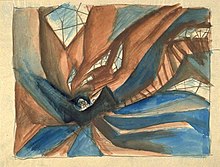Walter Röhrig
Walter Röhrig (born April 13, 1892 in Berlin , † December 6, 1945 in Caputh ) was one of the most important German film architects .
Life
Röhrig had received theoretical and practical training in Berlin and Zurich and worked as a backdrop painter at theaters in both cities. He also worked as a painter on the side. In 1919, Walter Röhrig made his film debut at the side of the leading production designer of those years, Hermann Warm , who brought him in for the extensive painting work on Otto Rippert's opulent Renaissance manners, The Plague in Florence . At Warm's side, Röhrig also worked on the masterpiece of cinematic expressionism, Robert Wienes Das Cabinet des Dr. Caligari .
During the shooting of the film Masks (1920), Röhrig met his young colleague Robert Herlth . For the next 16 years, the two production designers formed a solid team. The team of architects equipped some of the most famous quality productions - from 1923 to 1936 exclusively for UFA - in German film history. The duo was initially limited to artistic quality and complex large-scale productions such as Arthur von Gerlach to chronicle Grieshuus , FW Murnau's The Last Laugh , Tartuffe and Faust and Hans Kyser's Luther - A film of the German Reformation - films of international standing, where the team Roehrig / Herlth faced the most diverse architectural tasks.
In 1928 Murnau, who had emigrated to Hollywood in the meantime, engaged Röhrig to design his second US production, Four Devils . With the dawn of the age of talkies, both architects intensified their activities, they also designed the decorations for artistically much less ambitious productions (comedies, romances, historical material). Herlth and Röhrig's most creative achievements during the early 30s include the splendid, historicizing equipment musical Der Kongress tanzt , the restorative Fridericus adoration, The Flute Concerto by Sans-souci and the no less patriotic soldier portrait of Yorck , both films made by Gustav Ucicky , as well as the China fairy tale Princess Turandot and Ludwig Berger's composer biography Waltz War .
Shortly after the two designers tried to direct - the fairy tale film Hans im Glück - Röhrig and Herlth split up. While Robert Herlth continued his top career in quite different entertainment productions, Röhrig worked primarily for the Nazi propagandist Karl Ritter and his militaristic productions from 1937 . Works for other successful directors of the Third Reich who were true to the line, such as Ucicky ( Homecoming ) and Veit Harlan ( My Son, the Minister ), were also characterized by politically brown undertones. Only in his final phase of work did Röhrig also design pure entertainment goods without any obvious Nazi messages.
Walter Röhrig died a good six months after the end of the war near Potsdam . His son Peter Röhrig , born in 1923, made a name for himself as an architect in film and television after the war.
Filmography
- 1919: The plague in Florence
- 1919: The cabinet of Dr. Caligari
- 1920: masks
- 1920: The laughing horror
- 1920: The Isle of the Dead
- 1921: The Secret of Bombay
- 1921: Vogelöd Castle
- 1921: The tired death
- 1921: Parisian women
- 1921: Miss Julie
- 1922: Luise Millerin
- 1922: The Earl of Essex
- 1923: The treasure
- 1925: On the Grieshuus chronicle
- 1924: the last man
- 1925: Tartüff
- 1926: Faust
- 1927: Luther - A film of the German Reformation
- 1928: Looping the Loop
- 1928: Vier Teufel ( 4 Devils )
- 1928: asphalt
- 1929: The wonderful lie of Nina Petrovna
- 1929: Manolescu
- 1929: The Night After The Betrayal ( The Informer )
- 1929: The Immortal Lump
- 1930: Rose Monday
- 1930: hocus-pocus
- 1930: The Sans-souci flute concert
- 1931: In the secret service
- 1931: Congress dances
- 1931: Yorck
- 1932: The Countess of Monte Christo
- 1932: Man without a name
- 1932: The black hussar
- 1933: Me and the Empress
- 1933: Season in Cairo
- 1932: Dawn
- 1933: Waltz War
- 1933: refugees
- 1934: The Czardas Princess
- 1934: The young Baron Neuhaus
- 1934: Princess Turandot
- 1935: Barcarole
- 1935: The girl Johanna
- 1935: Amphitryon
- 1935: King Waltz
- 1935: Hans im Glück (also co-director)
- 1936: Savoy Hotel 217
- 1936: Under a hot sky
- 1937: My son, the Minister
- 1937: patriots
- 1937: diamonds
- 1937: Michael company
- 1937: Vacation on word of honor
- 1938: Capriccio
- 1938: Pour le Mérite
- 1938: The honeymoon
- 1940: Bal paré
- 1940: About everything in the world
- 1941: Cadets
- 1941: homecoming
- 1941: Rembrandt
- 1942: love stories
- 1942: The small border traffic
- 1943: Dangerous spring
- 1945: Via Mala
- 1945: a great day (premiere: 1954)
- 1945: The tavern for eternal love (unfinished)
literature
- Ron Schlesinger: cows, beetles, high animals. Robert Herlths and Walter Röhrig's HANS IM GLÜCK (1936) between experimental fairy tale films and propagandistic "big fun" . In: Filmblatt, Volume 16, No. 46/47, Winter 2011/12, ISSN 1433-2051 , pp. 85-94.
- Kay Less : The film's great personal dictionary . Volume 6: N - R. Mary Nolan - Meg Ryan. Schwarzkopf & Schwarzkopf, Berlin 2001, ISBN 3-89602-340-3 , p. 599.
Web links
- Walter Röhrig in the Internet Movie Database (English)
| personal data | |
|---|---|
| SURNAME | Röhrig, Walter |
| BRIEF DESCRIPTION | German film architect |
| DATE OF BIRTH | April 13, 1892 |
| PLACE OF BIRTH | Berlin |
| DATE OF DEATH | December 6, 1945 |
| Place of death | Caputh |
